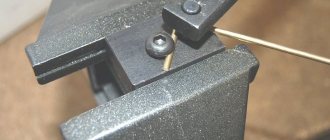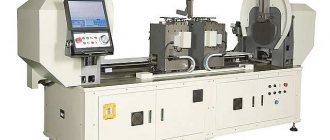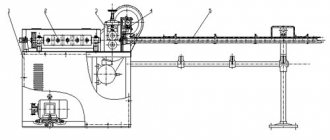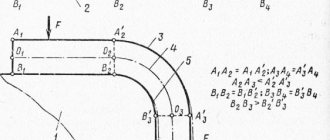Wire bending, performed either manually or using various tools and special equipment, allows products made from this material to be given different configurations. During the bending process, the inner layer of the wire is subjected to compression, and the outer layer is subjected to tension. Wire bending machines, which today are presented in a wide variety of models, are very popular, since bent wire products are actively used to solve various industrial and household problems.
The simplest device for bending wire
To perform bending operations at home without any problems, it is best to choose wire made from soft materials. Simple bending of stiffer wires, if necessary, can be carried out using ordinary plumbing tools:
- pliers (with the help of such a tool, which every home craftsman has, you can form a simple bend in the wire, as well as securely fix its segment for further processing);
- pliers (using this tool, which is one of the types of pliers, you can perform bending of varying degrees of complexity);
- wire cutters or needle nose pliers (using such a tool, the wire can be cut into pieces of the required length).
Simple techniques for manual wire bending
If you need to make a product of complex configuration from wire using the bending method, it is better to first draw it on paper and periodically check the sketch. To form the simplest figures, such a sketch does not need to be used. For example, if you need to create a bent product of a rectangular shape, you can do this as follows:
- The wire at the place of its future bend is clamped in a bench vice.
- The upper (not clamped) part of the wire is bent using ordinary pliers or a hammer.
As a result of this simple procedure, a bend at a right angle is formed on the surface of the wire.
To produce a large number of similar wire parts, templates and homemade devices are used.
Manual bending rules
If you are going to manually bend the wire, you must adhere to a number of recommendations that will allow you to complete this procedure without harm to your own health.
- All bending procedures should be carried out only with gloves made of thick fabric.
- The wire that is being bent must be secured in a vice as securely as possible so that it does not jump out during operation.
- All tools and equipment that you are going to use for work must be in good working order and perform their assigned functions efficiently.
- Heavy tools and equipment that you use when bending should not be placed on the edge of the workbench, so as not to accidentally hit them and drop them on your feet.
- When carrying out all manipulations with the wire bending tool with one hand, the other should be kept as far as possible from the future bend. Pliers or any other tool can break off and injure a hand located close to the bending area.
Wire bending using improvised means is possible only in small quantities, since such a procedure is quite labor-intensive. In addition, this operation can only be used to create products of the simplest configuration.
A specialized wire bending machine allows you to produce various products in large volumes, including those with complex shapes.
DIY wire bending device - Do it yourself
Wire bending, performed either manually or using various tools and special equipment, allows products made from this material to be given different configurations.
During the bending process, the inner layer of the wire is subjected to compression, and the outer layer is subjected to tension.
Wire bending machines, which today are presented in a wide variety of models, are very popular, since bent wire products are actively used to solve various industrial and household problems.
The simplest device for bending wire
To perform bending operations at home without any problems, it is best to choose wire made from soft materials. Simple bending of stiffer wires, if necessary, can be carried out using ordinary plumbing tools:
- pliers (with the help of such a tool, which every home craftsman has, you can form a simple bend in the wire, as well as securely fix its segment for further processing);
- pliers (using this tool, which is one of the types of pliers, you can perform bending of varying degrees of complexity);
- wire cutters or needle nose pliers (using such a tool, the wire can be cut into pieces of the required length).
Simple techniques for manual wire bending
If you need to make a product of complex configuration from wire using the bending method, it is better to first draw it on paper and periodically check the sketch. To form the simplest figures, such a sketch does not need to be used. For example, if you need to create a bent product of a rectangular shape, you can do this as follows:
- The wire at the place of its future bend is clamped in a bench vice.
- The upper (not clamped) part of the wire is bent using ordinary pliers or a hammer.
As a result of this simple procedure, a bend at a right angle is formed on the surface of the wire.
To produce a large number of similar wire parts, templates and homemade devices are used.
Working with a wire bending machine
To produce a large number of bent products from wire, various techniques can be used, each of which uses special equipment. The most common and economical method is the coil bending method.
Bending using this technology occurs in several stages.
- The wire, which is wound on coils, is fed to a two-plane roller machine, which aligns it.
- After alignment, the wire is fed to a wire bending machine, on which the product of the required configuration is formed.
- The formed product is cut off, and the entire bending cycle is repeated again.
The use of this technology allows you to fully automate the bending process and thereby achieve high productivity.
Budget wire bending machine
A wire bending machine can also look like a stationary template around which the wire is rolled using movable pressure rollers. Using such devices, bends of even the smallest radius can be formed on the surface of the wire, the value of which is comparable to the outer diameter of the workpiece. At the same time, the configuration of the product formed on such a machine can be quite complex.
The adjustable stops and variable arms of this template allow you to create many combinations of wire bends
A wire bending machine can also operate on the principle of pushing the workpiece through a system of rollers. When using such equipment, the end of the wire is connected to a special wire, which pulls the product through the working parts of the machine. A wire bending machine of this type, due to the features of its design, allows the production of products with even very complex shapes.
When leveling the wire, a wire bending machine is also used, which in this case is used for straightening. The working parts of such equipment can be straight frames or two-plane straight blocks. At the same time, rotating straightening frames are more efficient, which is why they are used in cases where leveling the surface of the wire needs to be done as smoothly and efficiently as possible.
What is used for bending wire? How to make a machine with your own hands!
Objects of various configurations and purposes can be made from wire. During work, it is important to bend the material correctly, therefore, when the diameter of the metal thread is more than 1 mm, it is advisable to use special devices.
The main types of this type of tool, as well as how to make a wire bending machine with your own hands, will be discussed in this article.
Basic bending methods
If it is necessary to perform a small amount of work, then hand tools are used to bend the wire. For bending soft metal materials or when the wire diameter does not exceed 3 mm, pliers or round nose pliers are used. These tools allow you to securely clamp a part of the product in one tool, and use another to bend the wire to the desired angle.
In this way, you can bend the material using a carpenter's vice. In this case, the wire is fixed in a vertical position, and the change in direction is also carried out using pliers or any other clamping device or mechanism.
If it is necessary to make a rounded bend, then for this purpose any rod of suitable diameter is used, which is also clamped in a vice. A rounded bend will need to be made when making springs from elastic wire yourself.
To do this, it is enough to clamp a rod or pipe of a suitable diameter in a vice, fix the end of the wire on one side, and use pliers to wind the wire the required number of turns.
If the wire has to be bent too often, then the most correct solution would be to purchase special devices or machines.
Tools for bending this material are a design in which the wire is clamped and bent using human muscle power. Machine tools usually use electric drives, and for the manufacture of complex products such machines are equipped with electronic controls.
Rules for work
Wire bending is not a complicated process, but to work effectively with this material you must adhere to the following rules:
- For work, you must use gloves made of thick fabric.
- Use only working tools and automatic machines.
- If a vice is used to perform this operation, then before starting the process, you must make sure that the workpiece is securely fixed.
- Before bending, the workpiece should be leveled.
Following these recommendations will help prevent scraps and injuries in the event of a sudden release of material from the holding device. You should also take care of the wiring and proper grounding when using machines that run on electricity.
Equipment use
If the volume of work is large enough, then equipment equipped with an electric motor will allow you to perform a large number of operations. The use of machines will significantly increase labor productivity, but at the initial stage it will be necessary to make some efforts to study the process of operation of a wire bending machine.
The most economical machine for bending wire is considered to be coil equipment, in which the material is supplied from bulk coils.
The process of bending wire on such equipment is carried out in the following order:
- The wire from the coil is fed to a roller mechanism, which aligns the material.
- The straightened wire enters the bending mechanism.
- At the next stage, bending and separation of the wire products occurs.
- After cutting the finished product, the process is repeated.
To make wire bending work as comfortable as possible, CNC machines are used.
Despite the significant cost of such equipment, the return on investment in a business occurs within a few months. Machines equipped with a microprocessor allow not only to fully automate the process, but also to carry out welding work on curved products.
DIY device
If the wire bending device will be used only for home work, then you can make a manual machine yourself. Equipment made with your own hands will not be highly productive, but for performing daily operations in a small volume such a product will be quite sufficient.
For a homemade machine you will need to prepare the following materials:
- Sheet steel 4 mm.
- Steel rod 20 mm.
- Profile pipe 20*20 mm and 30*30 mm.
- Two 12 mm nuts.
- Steel pipe ¾.
- Bolt 12 * 70 mm.
- Bushing from the reaction rod of a VAZ 2106 car.
To perform this work you will also need to prepare the following tools:
- grinder;
- welding machine;
- drill and metal drill bit 20 mm.
A device for bending wire is made with your own hands in the following sequence:
- A rectangle measuring 150*80 mm is cut out of a steel sheet using a grinder.
- Stepping back approximately 30 mm from the shorter side, you need to make a hole with a diameter of 20 mm exactly in the middle.
- Cut a piece 45 mm long from the metal rod.
- Place a piece of rod into the previously made hole and weld it on the back side.
- Cut a 70*30 mm rectangle from a metal sheet.
- Make two holes with a diameter of 16 mm in the 70*30 mm plate. The holes should be equidistant from the edges of the plate, and the distance between them should be 20 mm.
- Weld M12 nuts to the 70*30 mm plate so that they align with the holes made earlier. In order to perfectly center the nuts before welding, it is recommended to place them on a bolt, which should be threaded into the hole.
- Cut a piece 45 mm long from a ¾ steel pipe.
- Weld a 70*30 mm plate to the resulting cylinder made of a metal pipe, so that the pipe hole is in the same row as the previously drilled 16 mm holes. When performing this work, the plate should be placed exactly in the middle of the height of the steel cylinder.
- Cut a piece 400 mm long from a 30*30 mm profile pipe.
- Weld a section of profile pipe to a 70*30 mm steel plate. The metal connection is made on the side opposite to the welded cylinder. This will create a lever with a cylinder and 2 holes at the end.
- A piece 100 mm long is cut from a 20*20 mm profile pipe.
- A section of profile pipe is welded to the edge of a 150*80 mm plate. This element must be positioned from one of the corners to the level of the previously welded metal rod.
- Cut a 70*40 mm plate from a metal sheet. This part will be intended to support the workpiece, so it must also be welded to a section of the profile pipe.
- The torque bushing fits onto a 12 mm bolt, which should then be screwed into a nut welded to the lever.
- The lever with the bushing is fitted as a cylinder onto a piece of metal rod welded to the frame.
- To securely fix the machine during operation, it is recommended to secure the frame to a flat horizontal surface using threaded connections or welding.
The manufacture of the machine can be considered completed.
Wire bending is carried out as follows:
- The workpiece is placed on the side platform so that the front part is inserted into the gap between the central cylinder and the bushing attached to the lever.
- The lever rotates to the required angle.
- The workpiece is removed from the machine, trimmed and used for its intended purpose.
If the homemade machine was made of high-quality materials, and the welding seams were made at a professional level, then the device can be used not only for processing wire. In this case, it is possible to use the product for bending pipes, including profile pipes, with a diameter of up to 10 mm.
Watch the video where a man shows how to assemble a simple structure of a reinforcement bender for bending rods and squares:
The second video shows an overview of the mechanism for bending wire and curling hooks:
Conclusion
What is used for bending wire is described in detail in the article. To work with this material, you can use both simple tools and complex installations that allow you to perform a large number of operations per minute.
If you have a limited budget, you can independently make a mechanical device that will not be inferior in quality to factory products.
Types of professional equipment
The simplest type of professional equipment used to bend wires are machines with one console. Meanwhile, such devices can only produce products of simple geometric shapes, the development length of which does not exceed 1000 mm.
More complex products with a development length of over 1000 mm make it possible to create double-cantilever equipment, in which the workpiece is deformed simultaneously from both ends. This machine can produce products with many complex curves.
The most complex wire products allow the creation of 3D machines on which bending can be performed simultaneously in three dimensions. The machines of this category are endowed with such unique functions by a rotary bending console, all movements of which are controlled by an electronic automated system. Despite all the advantages of processing using such equipment, it is quite expensive, so these machines are used in exceptional cases.










